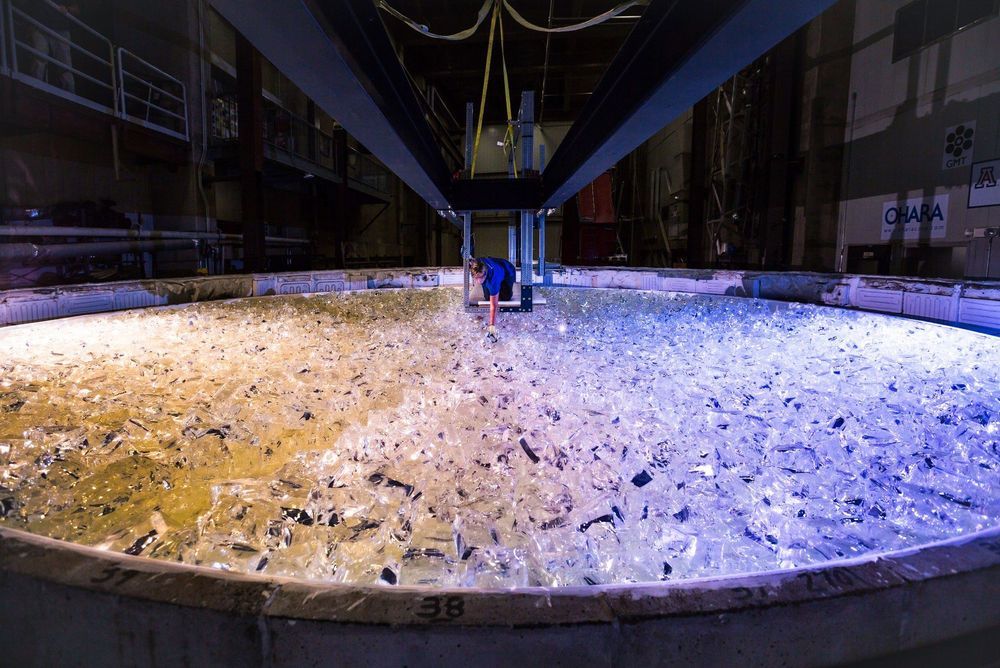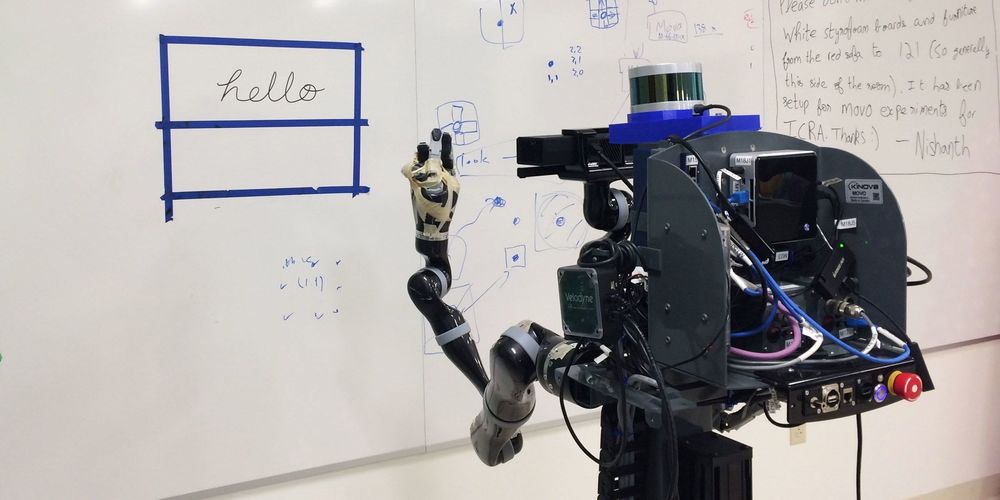Page 8796
May 27, 2019
The Astounding Engineering Behind the Giant Magellan Telescope
Posted by Genevieve Klien in categories: education, engineering, habitats, space
It’s easy to miss the mirror forge at the University of Arizona. While sizable, the Richard F. Caris Mirror Laboratory sits in the shadow of the university’s much larger 56,000-seat football stadium. Even its most distinctive feature—an octagonal concrete prominence emblazoned with the school’s logo—looks like an architectural feature for the arena next door. But it’s that tower that houses some of the facility’s most critical equipment.
Inside the lab, a narrow, fluorescent-green staircase spirals up five floors to the tower’s entrance. I’m a few steps from the top when lab manager Stuart Weinberger asks, for the third time, whether I have removed everything from my pockets.
“Glasses, keys, pens. Anything that could fall and damage the mirror,” he says. Weinberger has agreed to escort me to the top of the tower and onto a catwalk some 80 feet above a mirror 27.5 feet in diameter. A mirror that has already taken nearly six years—and $20 million—to make. “Most people in the lab aren’t even allowed up here,” he says. That explains Weinberger’s nervousness about the contents of my pockets (which are really, truly empty), and why he has tethered my camera to my wrist with a short line of paracord.
Continue reading “The Astounding Engineering Behind the Giant Magellan Telescope” »
May 27, 2019
Researchers develop wood that can cool a home
Posted by Genevieve Klien in categories: habitats, materials
Wood has a series of tiny structures inside that are used to carry water and nutrients to all parts of a living tree. Scientists have now figured out how to harness those same small structures to keep a home cool. Researchers at the University of Maryland and the University of Colorado Boulder say that the material could save 20% in AC bills.
May 27, 2019
Astronomers investigate pulsar wind nebula DA 495
Posted by Genevieve Klien in categories: cosmology, particle physics, space travel
Astronomers have carried out a multiwavelength investigation of a pulsar wind nebula (PWN), designated DA 495, to unveil its mysterious physical nature. Results of the study, based on observations using HAWC and VERITAS ground-based observatories as well as NASA’s NuSTAR spacecraft, are presented in a paper published May 17 on arXiv.org.
Pulsar wind nebulae (PWNe) are nebulae powered by the wind of a pulsar. Pulsar wind is composed of charged particles; when it collides with the pulsar’s surroundings, in particular with the slowly expanding supernova ejecta, it develops a PWN.
Particles in PWNe lose their energy to radiation and become less energetic with distance from the central pulsar. Multiwavelength studies of these objects, including X-ray observations, especially using spatially-integrated spectra in the X-ray band, have the potential of uncovering important information about particle flow in these nebulae. This could unveil important insights into the nature of PWNe in general.
Continue reading “Astronomers investigate pulsar wind nebula DA 495” »
May 27, 2019
This New State of Matter Is a Liquid and a Solid at the Same Time!
Posted by Klaus Baldauf in categories: particle physics, quantum physics, robotics/AI, space

Scientist have just discovered that, at an atomic level, these elements have both liquid and solid states, giving context to what may be hidden in the cores of celestial bodies.
A New State of Water Reveals a Hidden Ocean in Earth’s Mantle — https://youtu.be/pgm4z8vJVVk
Continue reading “This New State of Matter Is a Liquid and a Solid at the Same Time!” »
May 27, 2019
Scientists Discover How Blind People Know So Much About Appearances
Posted by Genevieve Klien in category: futurism
The philosopher John Locke, who believed that true knowledge of the world could only stem from sensory experiences, thought that blind individuals could never understand the concepts of light and color. Locke, it turns out, was wrong. In a recent PNAS study, blind people demonstrate that they do understand what sighted people process through vision, proving that “visual” ideas don’t actually require sight.
In the study published Tuesday, scientists demonstrated how blind people make visual sense of what they cannot see. While previous studies suggested that the most efficient way for a blind person to know that, say, a flamingo is pink, is to memorize that fact, this study demonstrates that blind people instead look at the world like scientists and make sense of the visual world through a catalogue of clues.
“First-person experience isn’t the only way to develop a rich understanding of the world around us,” co-author and Johns Hopkins doctoral candidate Judy Kim explains. “People often have the intuition that we can’t know what we can’t see.”
Continue reading “Scientists Discover How Blind People Know So Much About Appearances” »
May 27, 2019
This Crafty Robot Can Write in Languages It’s Never Seen Before
Posted by Genevieve Klien in category: robotics/AI
After training to hand-write Japanese characters, the robot could then copy words in Hindi, Greek, and English just by looking at examples.
May 27, 2019
Quantum information in quantum cognition
Posted by Genevieve Klien in categories: neuroscience, particle physics, quantum physics
Some research topics, says conventional wisdom, a physics PhD student shouldn’t touch with an iron-tipped medieval lance: sinkholes in the foundations of quantum theory. Problems so hard, you’d have a snowball’s chance of achieving progress. Problems so obscure, you’d have a snowball’s chance of convincing anyone to care about progress. Whether quantum physics could influence cognition much.
Quantum physics influences cognition insofar as (i) quantum physics prevents atoms from imploding and (ii) implosion inhabits atoms from contributing to cognition. But most physicists believe that useful entanglement can’t survive in brains. Entanglement consists of correlations shareable by quantum systems and stronger than any achievable by classical systems. Useful entanglement dies quickly in hot, wet, random environments.
Brains form such environments. Imagine injecting entangled molecules A and B into someone’s brain. Water, ions, and other particles would bombard the molecules. The higher the temperature, the heavier the bombardment. The bombardiers would entangle with the molecules via electric and magnetic fields. Each molecule can share only so much entanglement. The more A entangled with the environment, the less A could remain entangled with B. A would come to share a tiny amount of entanglement with each of many particles. Such tiny amounts couldn’t accomplish much. So quantum physics seems unlikely to affect cognition significantly.
Continue reading “Quantum information in quantum cognition” »
May 27, 2019
Chinese scientists develop transistors about the width of a human DNA strand
Posted by Klaus Baldauf in category: computing
Beijing team believes it has solved problem of powering tens of billions of nanometre-sized transistors without burning out the chip.
May 27, 2019
For The First Time, DNA Has Been Edited With CRISPR in Space
Posted by Genevieve Klien in categories: biotech/medical, genetics, space
Humans may not be able to burp properly in space, but we can now edit a genome. For the first time, astronauts aboard the International Space Station (ISS) have used CRISPR-Cas9 to edit the DNA of brewer’s yeast.
The goal wasn’t to create super space yeast. The astronauts were studying how DNA repair mechanisms work in space, so they snipped through strands of the fungus’s genetic code in a number of places to mimic radiation damage.
“The damage actually happens on the space station and the analysis also happens in space,” said Emily Gleason of miniPCR Bio, the company that designed the DNA lab aboard the ISS. “We want to understand if DNA repair methods are different in space than on Earth.”
Continue reading “For The First Time, DNA Has Been Edited With CRISPR in Space” »

















